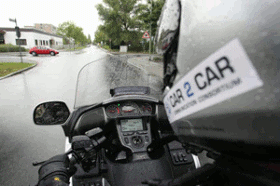 One of the most dangerous aspects of riding a motorcycle is not being seen by other motorists in traffic. But using vehicle-to-vehicle (V2V) communication, drivers in cars, trucks and buses would be able to know that a motorcycle is nearby -- without ever having to look for or even hear it.
One of the most dangerous aspects of riding a motorcycle is not being seen by other motorists in traffic. But using vehicle-to-vehicle (V2V) communication, drivers in cars, trucks and buses would be able to know that a motorcycle is nearby -- without ever having to look for or even hear it.
This could go a long way toward lowering the recent rise in motorcycle traffic fatalities, which is why the two-wheel vehicles have been added to the federal government’s massive connected-car field trial currently under way in Ann Arbor, Mich.
For the study, which kicked off in August and involves more than 3,000 vehicles, the National Highway Transportation Safety Administration (NHTSA) is working with the University of Michigan Transportation Research Institute (UMTRI), automakers, technology suppliers and others to determine how V2V as well as vehicle-to-infrastructure (V2I) communication can help reduce accidents. At the end of the field trial, NHTSA will determine whether to mandate the technology for new vehicles.
Now two motorcycle manufacturers -- BMW and Honda -- have partnered with UMTRI and Cohda Wireless, which provides communication technology for the project, to take part in the field trial.
The motorcycles will participate in two tasks in the NHTSA field trial -- communications feasibility testing and motorcycle-to-vehicle performance testing -- to determine how they'll fit into the connected-car future. Like the other vehicles in the test, the motorcycles will use a long-range, secure form of Wi-Fi to communicate with other drivers long before they can see one another, such as when approaching a blind intersection.
Cohda and UMTRI also plan to test how motorcycles can communicate with traffic lights and other transportation infrastructure to alert riders to when a traffic light is about to turn red or there are dangerous curves ahead, for example.
NHTSA analysis has shown that connected-vehicle technology could potentially help prevent an estimated 80 percent of crashes involving non-impaired drivers. NHTSA data has also revealed that while motorcycle accidents represent only 5 percent of all highway fatalities, 80 percent of the accidents result in injury or death -- compared with 20 percent for cars. Hence, the importance of motorcycles in the agency’s overall road safety strategy and focus on lowering accidents and fatalities.
Source: MSN
No comments:
Post a Comment